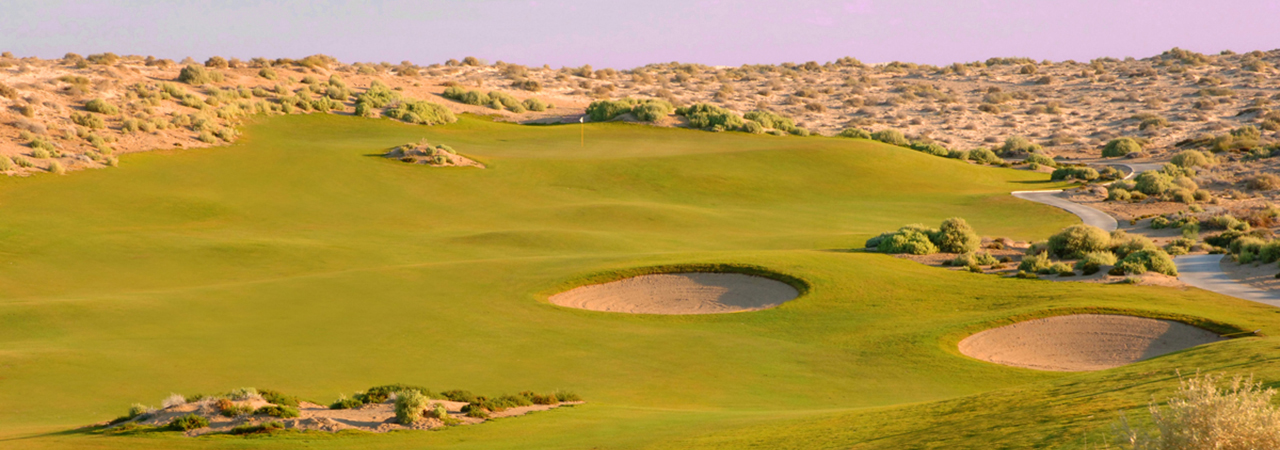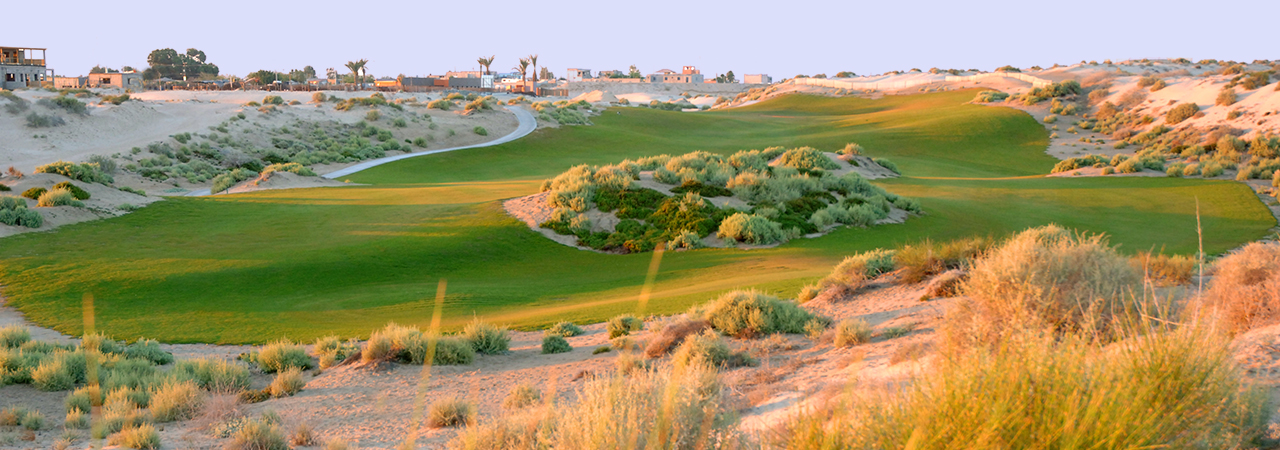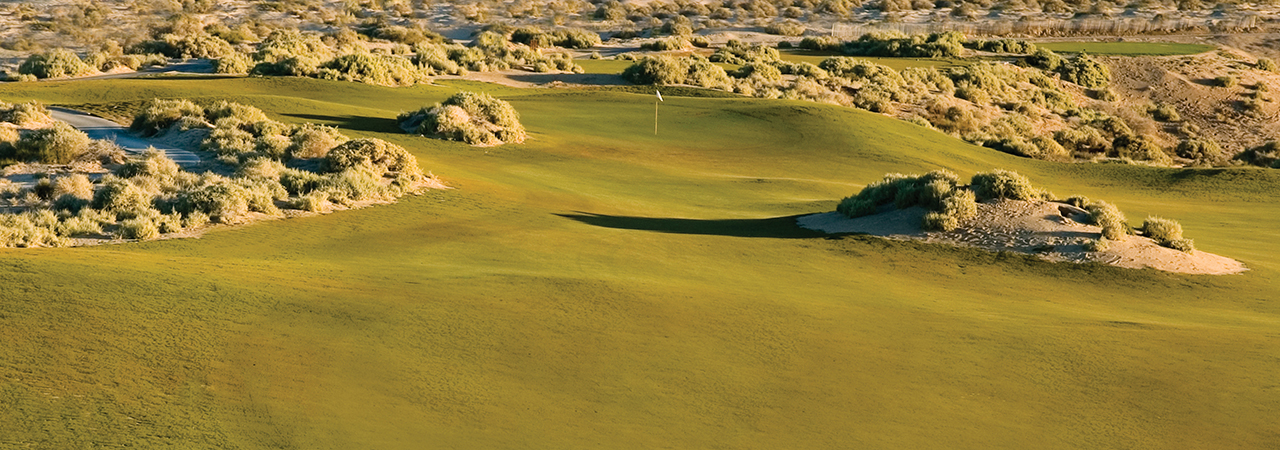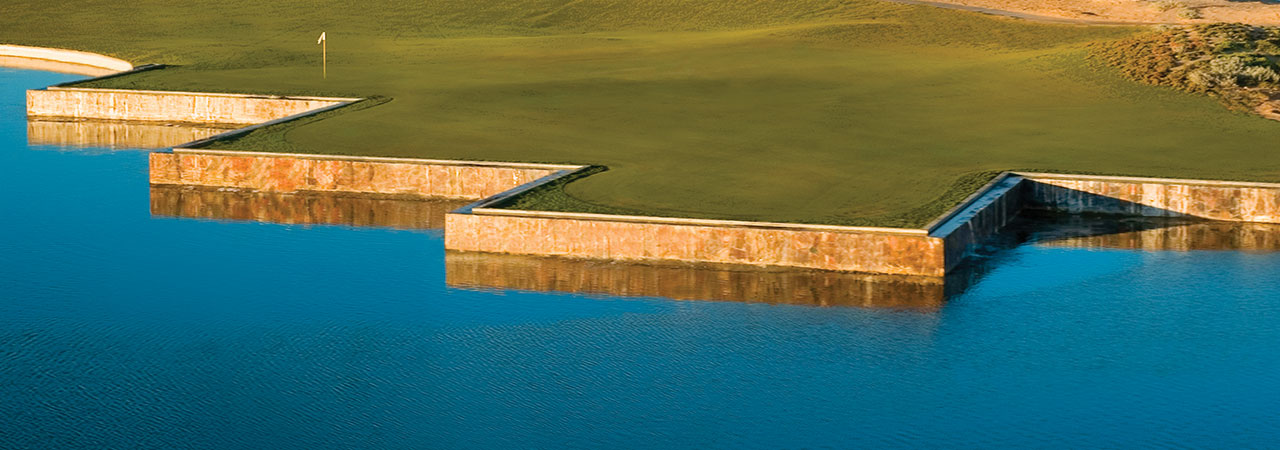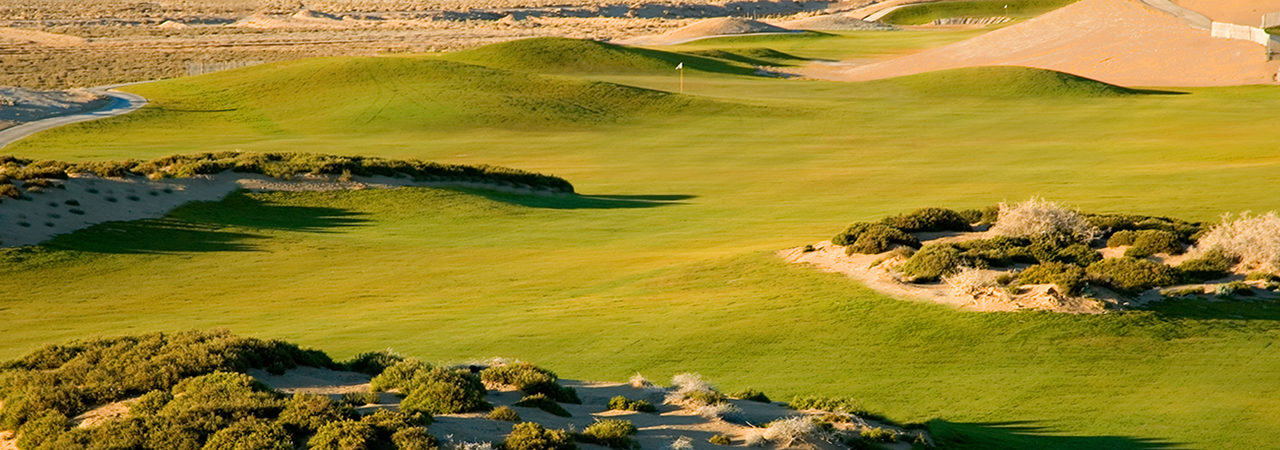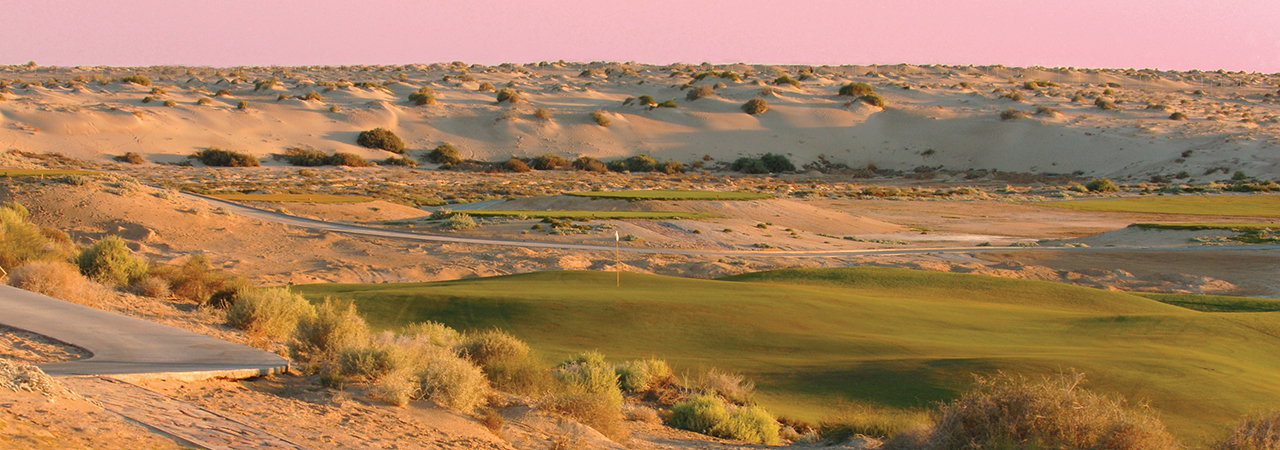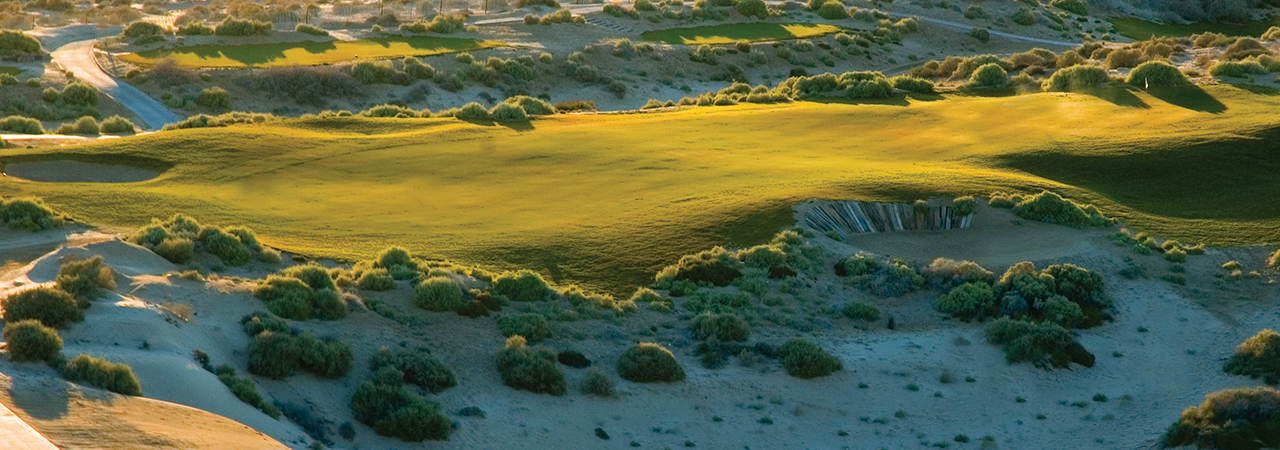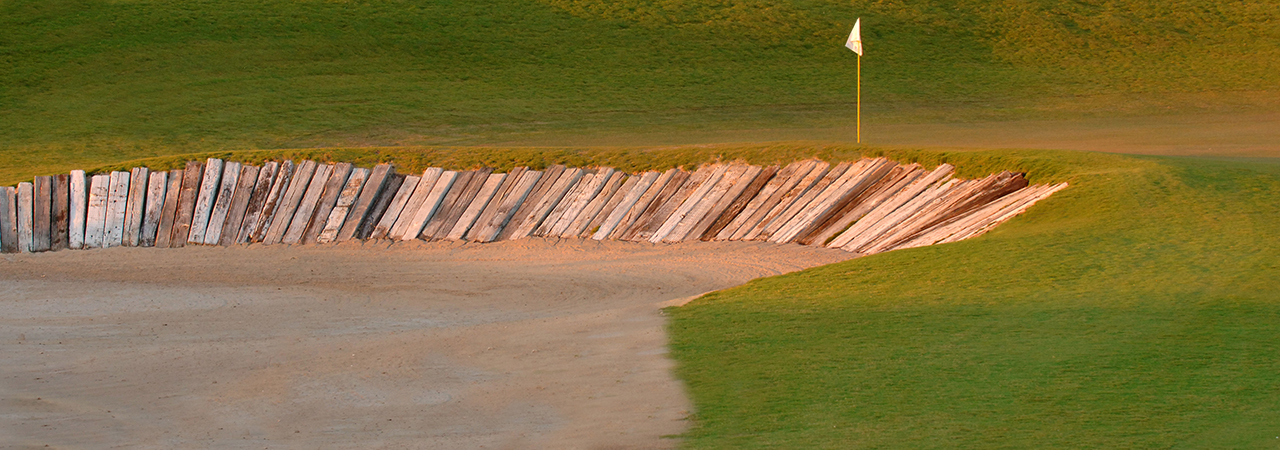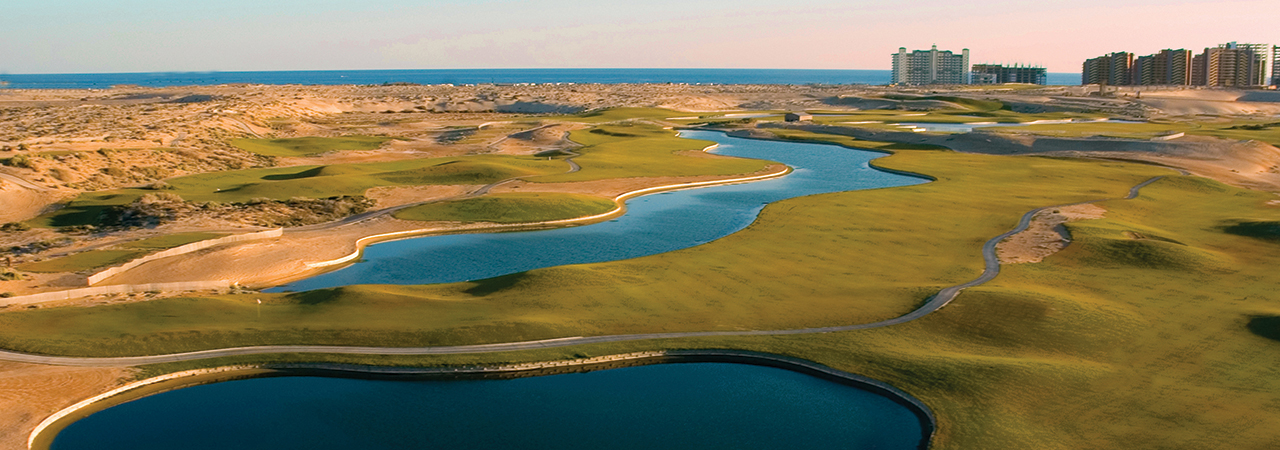accessible to all levels of skill…Where desert meets sea are blow-outs
of sand carved out by wind and held in place by native grasses…
only in such topography exist the ingredients for a true links golf course.
Project Overview
Golf, it is said, began among the dunes. On the remote shores of Scotland, where sandy lowland meets the sea, the traditions and challenges of great golf courses have remained virtually unchanged for the past 600 years. It is here that golfers enjoy the ‘links,’ a term which may be universally applied to golf, but is hardly appropriate for most courses. For only on true linksland can one experience the game as it was originally played. Only through sand dunes located along the sea can golfers relive this ancient game in all its glory. It is here — across unique landforms created by the wind and the tides – that the true spirit of golf unfolds. Only here are the hearts of golfers captured forever.
So where does one go for such spirit? Does the modern golfer have to travel afar to the British Isles? Must our quest for golf as it was meant to be include long-distance travel?
The Links at Las Palomas is one such place. A true links golf experience on the dunes above the Sea of Cortez. A remarkable golf course located in Puerto Peñasco, just a few hours south of Phoenix, Arizona and Southern California.
The story of The Links at Las Palomas began with passion. Golf course architects Forrest Richardson and Arthur Jack Snyder spent endless hours studying the land at Las Palomas. Their objective — to find the perfect land for an 18-hole course. In the end, their design included 19-holes — an extra “bonus hole” was “too perfect” not to be built. As the course came to life, shaping and details were brought to the surface. While it appeared they were ‘creating’ a golf course, both men admitted that their role was just as much about ‘finding’ a golf course. For on true linksland, golf goes where it is interesting and adventurous. Fairways become one with the landscape. Greens are nestled into pockets. Holes blend into the surrounds. Golf and land become intertwined.
For Richardson, creator of celebrated courses throughout the west, the course would eventually become symbolic of his long association with Snyder. Sadly, Snyder passed away in 2005, just as the first turf was being established at the course. Although Jack Snyder got to see some of his vision come to life, it was up to Richardson to put the finishing touches on the work. Richardson became a temporary resident in Peñasco, working alongside his trusted shapers, sculpting the course from the natural terrain.
Your journey at The Links at Las Palomas begins from atop a ridge. In the distance are a sprinkling of sand dunes and tranquil lagoons. From here the course meanders back into the dunes on two more occasions. Periodically, the Sonoran Desert gives way to views of the Sea of Cortez. You are faced with towering mounds of sand. “Blow-outs” as they are called. These are great dunes carved by the wind and held in place by native plants. The wise golfer learns to respect these hazards. “Bunkers turned inside-out,” some will say — no place be unless you are up for the adventure.
At Las Palomas the golfer will do well to consider a cardinal rule of links golf — the game is often played on the ground. There can often be just as much break on the fairways as one may find on the large and undulating greens. Besides, we have another foe wherever the land meets the sea. It is the wind. And where great golf is played, the wind is like another opponent to us. Its presence can be a blessing – or a curse. The smart player does not always hit the ball high and far. When the wind comes along — and it almost always does — golfers learn to play creative shots. Occasionally low. Sometimes curving. But always with dead aim.
The Links at Las Palomas is one of the first courses ever planted with a new variety of grass called Sea Dwarf Paspalum. Known for its perfect carpet-like appearance, Paspalum originated in South Africa along natural shorelines and marshes. It is ideal for such golf. Fast fairways and slick putting surfaces. Two qualities that go hand-in-hand to create a true links experience.
A round at The Links at Las Palomas is enjoyable for all levels of skill. The course can be attacked from the very back tees — at nearly 7,000-yards. Or, from members tee markers, club tees or forward tees. The lure of any golf course should be how often the golfer wants to return. The goal at this special course was to provide members and guests a layout that would never become tiring. A great test of golf is one which must be played over and over in order to conquer. At The Links at Las Palomas that becomes the goal of every golfer.
An Interview with Forrest Richardson
In 2005, golf course architect Forrest Richardson sat down and answered some questions about The Links at Las Palomas. Here is part of the interview:
What can we expect when the course is ready to play — what kind of course will it be?
Well, our goal is to make it a fun and enjoyable golf experience. That’s the primary goal. But, the best way to describe what we have created here is to focus on the tremendous sand dunes and how the course will play up, over, around and through these beautiful land forms. It is truly a links course, and it will be the only true links in the Sonoran Desert region.
You call it a “Links,” what exactly does that mean?
A links golf course is one that occupies true linksland. Linksland comes from the Scotish word ‘hlincas,’ which means a ridge or hill. So, only on land where the sea and wind have caused erosion and undulations do you get such land. This is where golf began, along the coast of Scotland on just such landforms. The game of golf developed in Scotland in around 1500 A.D., probably from traders who brought clubs from other parts of Europe where a game called het kolven had been played over ice. But, to answer the question, a links golf course is always by the sea and it requires natural dunes through which holes seem to fit naturally to the land. Not even Pebble Beach is on true linksland, it’s really a seaside course set on rocky cliffs.
Are all the holes links holes?
About half of them are in dunes areas — or links areas. The others wrap around lagoons and connect the course together from the top of the hill and then back to the ocean. But the feel is all links in spirit.
What about the course’s length, par, etc.
The course can be played from 5,000-yards to nearly 7,000-yards. From the normal tees it will be about 6,700-yards with a par of 72. All of the par-3s play to different lengths — and we’ve managed to face them in different directions. There are five par-3s, plus the little bonus hole that we call Hoyo Bonito. The par-5s are also of varying lengths. A few will beckon the player to try and get home in two shots, which always makes for a fun game.
Would you say it’s a difficult layout?
It depends on where you decode to play from. Our goal was to create a course which might look intimidating, but really plays quite fairly. Jack Snyder, my mentor and co-designer of Las Palomas, always believed in creating fair and friendly courses. We spoke about the course often, right up until he passed away in 2005. Jack would always ask how the final work was shaping up. One of his main concerns was giving every type of player a fun layout. This isn’t to say that the hazards are weak. We believe a hazard should provide some trouble for the golfer — after all, that’s how the game evolved. Plan ahead and avoid trouble and you will get to the green safely — take risks and you will either be rewarded or suffer a few additional strokes. The course will play tricks with golfers. Some of the holes and shots will appear easy, but the winds and elevations will have a say in the score. Let’s put it this way: The golf course will be difficult if you’re wild and not careful. On the other hand, if you think through the options it will reward you with pleasant shots and less trouble. In my opinion, courses which make the golfer think are always favorites.
What are the most difficult holes?
For me it will be No. 13, a long par-4 situated along a lagoon. But that’s because I don’t hit the ball very far. I think some of the most difficult holes will be the easiest in appearance. For example, the 7th is a short par-3 of not much over 120-yards. But the green is huge with multiple levels. What makes this fun is that all players are equalized — the long hitter has no advantage over the short hitter at the 7th. It’s all about accuracy and putting — you’ll have to be on your toes otherwise it’s a three-putt. Overall, the most demanding of the par-4 and par-5 holes are probably Nos. 2, 8, 13, 16, and 18. These are where matches will be decided in my opinion.
How many holes have water hazards?
Nos. 9 and 16 — both par-5s — play to a large double green that sits behind a lagoon. The lagoon runs all along both holes. in fact, the entire 9th hole is almost an island unto itself. These are the pinnacle of the water holes. Nos. 10, 11, and 12 are the others. So there are five holes that play along or across water. A few other holes have water for effect, but it really doesn’t come into play. Let’s say it’s there to calm your nerves!
What about the turf — what variety is it?
We are planting the newest strain of paspalum, called Sea Dwarw. Paspalum is a grass originally discovered in South Africa. It can survive on water which has abundant salts. In Peñasco we have lots of salt in the water, obviously because we are near the ocean. Paspalum is being used on some of the finest courses in Cabo, Hawaii and throughout the Carribeabn. It is an amazing grass. What is especially neat is that the entire course — tees, fairways and greens are all the same variety. The whole course will be a carpet of just a few different heights of turf. It will be much like Augusta in that regard. Augusta was originally laid out with no rough to speak of, just one height of grass through the hole until you reached the green. That is much the effect we will have here.
Do you have a style in your designs?
I suppose all golf architects have some common threads in their work. For me it probably comes from my studies across England, Scotland and Ireland. I like a sense of adventure in golf courses. We don’t lay out all of the course so you can necessarily see it all at once. I sometimes hide a few areas of the green. This creates a treasure hunt situation. The golfer can see the green, but perhaps not all of it. My goal is to have the player leave the course wanting to come back for another round. This usually means he or she will be looking forward to beating the course on the next round. Why? Because they will have discovered something that they didn’t see on the first visit. It’s the same thing that brings fishermen back to a lake or stream — they feel that their return visit will be more fruitful now that they have some experience.
We noticed that you have 19 holes — why an extra?
Bonus holes were common in the 1930s. And we see a few popping up even today. We felt that Las Palomas was a great site to add a short hole where golfers could settle their bets or just have some fun before of after a round. Our extra hole sits just below the clubhouse and it looks out at the Sea of Cortez. It’s about 100-yards downhill to a rolling green. We’ve also designed the 18th hole so you can play to an alternate green — the one usually used for the Bonus hole. This allows the course to play differently, which is a neat flexibility for the management.
Do you have a favorite hole?
I would say the 14th. It’s a short par-4, which are almost always have fun. This one is unlike anything we’ve ever done. A huge dune sits right in front of the green. You can play to the left, right or try and attack the dune straight away. And, it’s reachable because it’s downwind. The player has so many options that it’s really difficult to describe. I think it will be a favorite, but on the scorecard it doesn’t look like much.
How often are you here in Rocky Point working on the project?
Nearly every week. That’s the only way to get it right. The greatest golf courses are those with terrific land and where the designer spent time working with the shapers — the guys who operate the bulldozers. Our shaper, Tim Taynor, is very talented — but he can’t read my mind 100% of the time…only some of the time! I walk around with Tim and talk about shots to greens, how the course needs to look, etc. This is one of the most rewarding parts of golf course architecture – being there to help sculpt the finished pieces. I wouldn’t miss it for the world!
Quotes about The Links at Las Palomas from Forrest Richardson
“The course is a celebration of all that golf was meant to be — but with a twist. It’s as if the course was born to a Mexican mother and a Scottish father.”
“Besides the sand and the water, golfers will often have to play against one of the most feared and treacherous opponents ever — the wind. But, it is the presence of an ever-changing wind that makes many golf courses great.”
“Fun. That is what we tried to create at every turn. The problem with so many courses is that they are all about toughness and length. Sure, we have some tough holes and some long ones, too. But not everywhere. It’s nice to break up the round with some delicate short shots, some wild putts and a few holes you could never find anywhere but right here. That was the recipe we cooked up.”
“If I were your caddie, I would stand at the first tee and tell you that you are about to go on a golf adventure like you have never experienced before. Sure, maybe you have played in Ireland or Scotland. Probably north Scottsdale. And it’s likely you have been to Cabo. But this will be different. Here you are going to experience the true links spirit, but with a dose of ‘Margaritaville’ thrown in the blender. Tighten your seat belt. We’re going to have some fun.”
Quick Facts
Scope: Planning, Community Site Planning, Design, Approvals, Bidding, Construction Documents, Construction Observation Services, Branding & Signage
Course: 18-holes/Par-72/7,000-yards, Short Game Area, Range, Bonus Hole
Budget: $7.5 million USD
Completion: Opened 2007
Builder: SEMA Golf
Address: Diamonte 101, Blvd. Costero 150, Peñasco, Sonora, Mexico
Articles
Palomas Receives award for “International Development of the Year” (1-7-07)
Golf Crosses Arizona’s International Border (2-4-03)

